Analyzing the Enron Accounting Scandal: A Research Project
VerifiedAdded on 2019/12/03
|27
|9482
|123
Project
AI Summary
This accounting research project investigates the Enron scandal, a major case of financial fraud and manipulation in the U.S. The study examines the company's unethical practices, including the use of special purpose entities, mark-to-market accounting, and revenue recognition to misstate financial values and hide increasing debt. The project explores the impact of these practices on stakeholders such as shareholders, employees, and the government. It also analyzes the role of auditors and the failures in corporate governance that contributed to the scandal. The research further evaluates the government's response, including the Sarbanes-Oxley Act, and considers whether these measures were sufficient to prevent future accounting scandals. The findings discuss the loopholes in accounting and auditing practices that enabled the company to hide financial losses and debt. The project concludes with recommendations for improving corporate governance and auditing practices to prevent similar accounting scandals in the future. The study is based on secondary data collected from books, journals, and online sources, with proper citations.
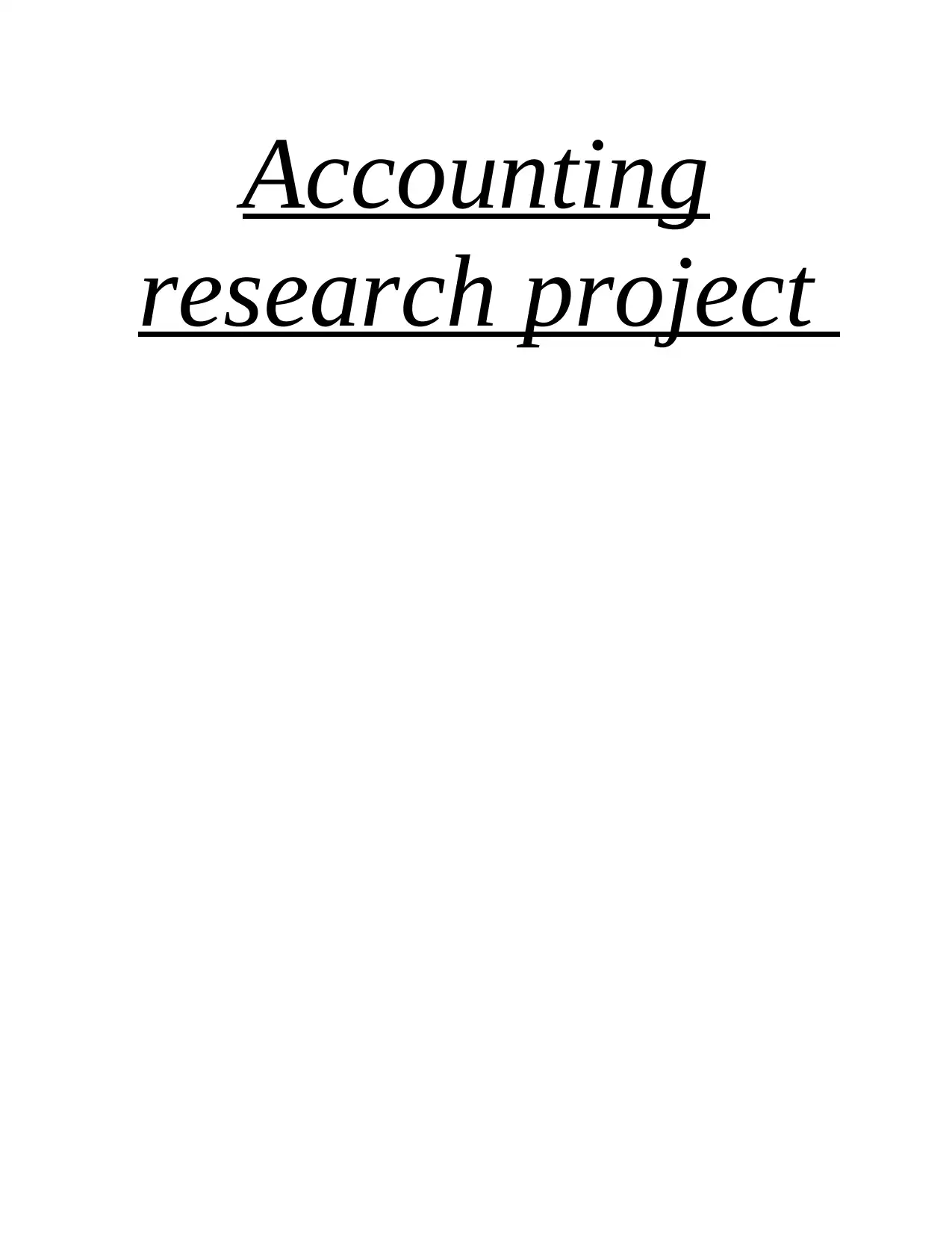
Accounting
research project
research project
Paraphrase This Document
Need a fresh take? Get an instant paraphrase of this document with our AI Paraphraser
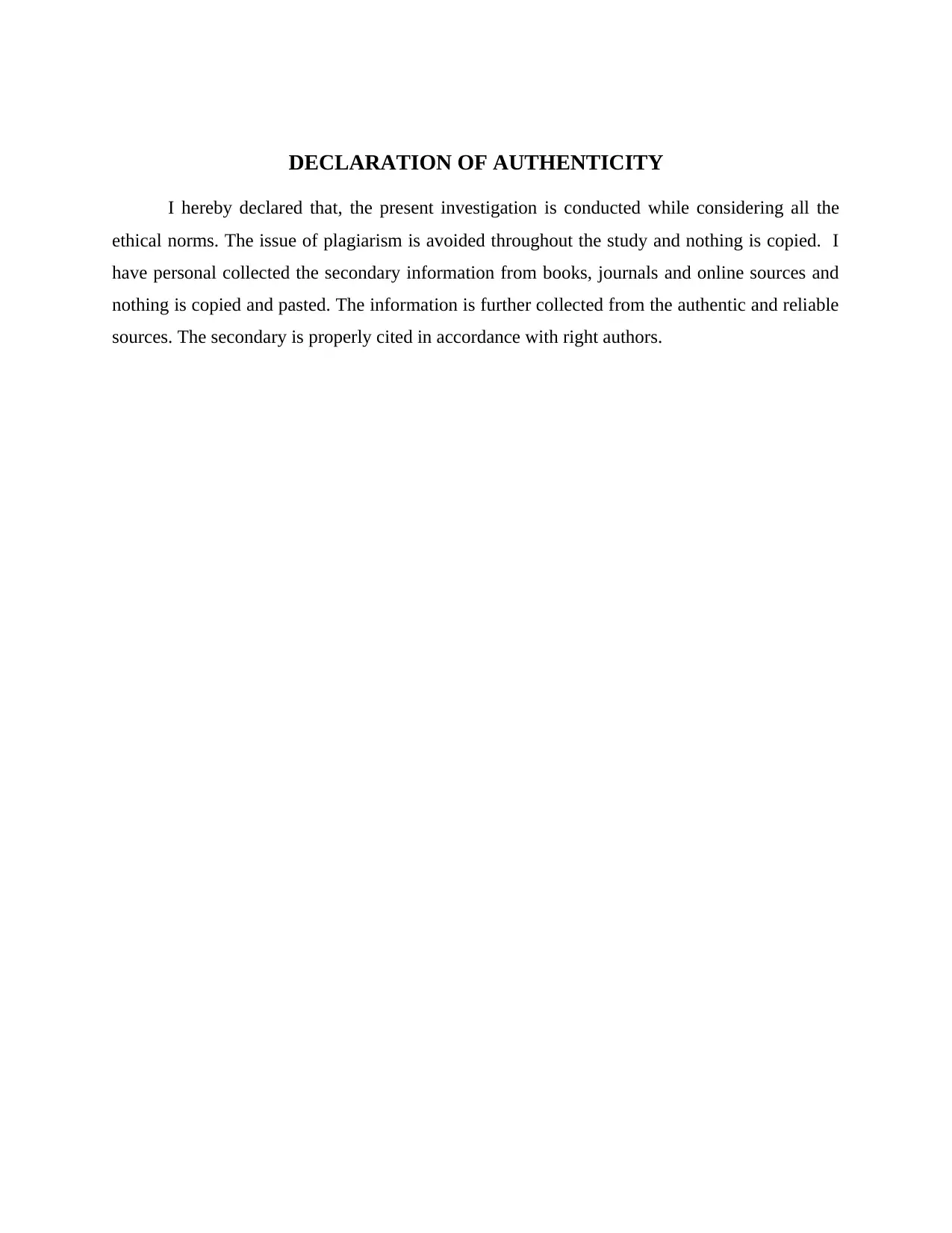
DECLARATION OF AUTHENTICITY
I hereby declared that, the present investigation is conducted while considering all the
ethical norms. The issue of plagiarism is avoided throughout the study and nothing is copied. I
have personal collected the secondary information from books, journals and online sources and
nothing is copied and pasted. The information is further collected from the authentic and reliable
sources. The secondary is properly cited in accordance with right authors.
I hereby declared that, the present investigation is conducted while considering all the
ethical norms. The issue of plagiarism is avoided throughout the study and nothing is copied. I
have personal collected the secondary information from books, journals and online sources and
nothing is copied and pasted. The information is further collected from the authentic and reliable
sources. The secondary is properly cited in accordance with right authors.

ABSTRACT
Accounting scandal of Enron is major case of fraud and manipulation in US. This scandal
was resulted due to unethical practices of directors and auditors of the company. It is seen in the
case that initially the company was able to generate good value for the business but later these
practices leaded to the situation of insolvency.
Insolvency of the company had affected various stakeholders such as shareholders,
employees, public, investors and government. Investigation in present study shows that the
company had manipulated their financial values in order to hide their increasing debt. Due to this
aspect, shareholders of the company had faced huge capital loss and employees of the company
had lost their money saved in retirement account of company.
Enron had made use of creative accounting practices for the misstatement of financial
values in the accounting records. As a consequence, there was a huge hidden cumulative profit
that had later made drastic reduction in the value of business. The fraudulent accounting
practices were adopted by the company through creation of Special purpose entity and
application of revenue recognition concept and mark to market accounting. Further, auditing
issues shows the manner in which auditor of the company failed to report accounting frauds
conducted by managerial parties.
Accounting scandal of Enron is major case of fraud and manipulation in US. This scandal
was resulted due to unethical practices of directors and auditors of the company. It is seen in the
case that initially the company was able to generate good value for the business but later these
practices leaded to the situation of insolvency.
Insolvency of the company had affected various stakeholders such as shareholders,
employees, public, investors and government. Investigation in present study shows that the
company had manipulated their financial values in order to hide their increasing debt. Due to this
aspect, shareholders of the company had faced huge capital loss and employees of the company
had lost their money saved in retirement account of company.
Enron had made use of creative accounting practices for the misstatement of financial
values in the accounting records. As a consequence, there was a huge hidden cumulative profit
that had later made drastic reduction in the value of business. The fraudulent accounting
practices were adopted by the company through creation of Special purpose entity and
application of revenue recognition concept and mark to market accounting. Further, auditing
issues shows the manner in which auditor of the company failed to report accounting frauds
conducted by managerial parties.
⊘ This is a preview!⊘
Do you want full access?
Subscribe today to unlock all pages.

Trusted by 1+ million students worldwide
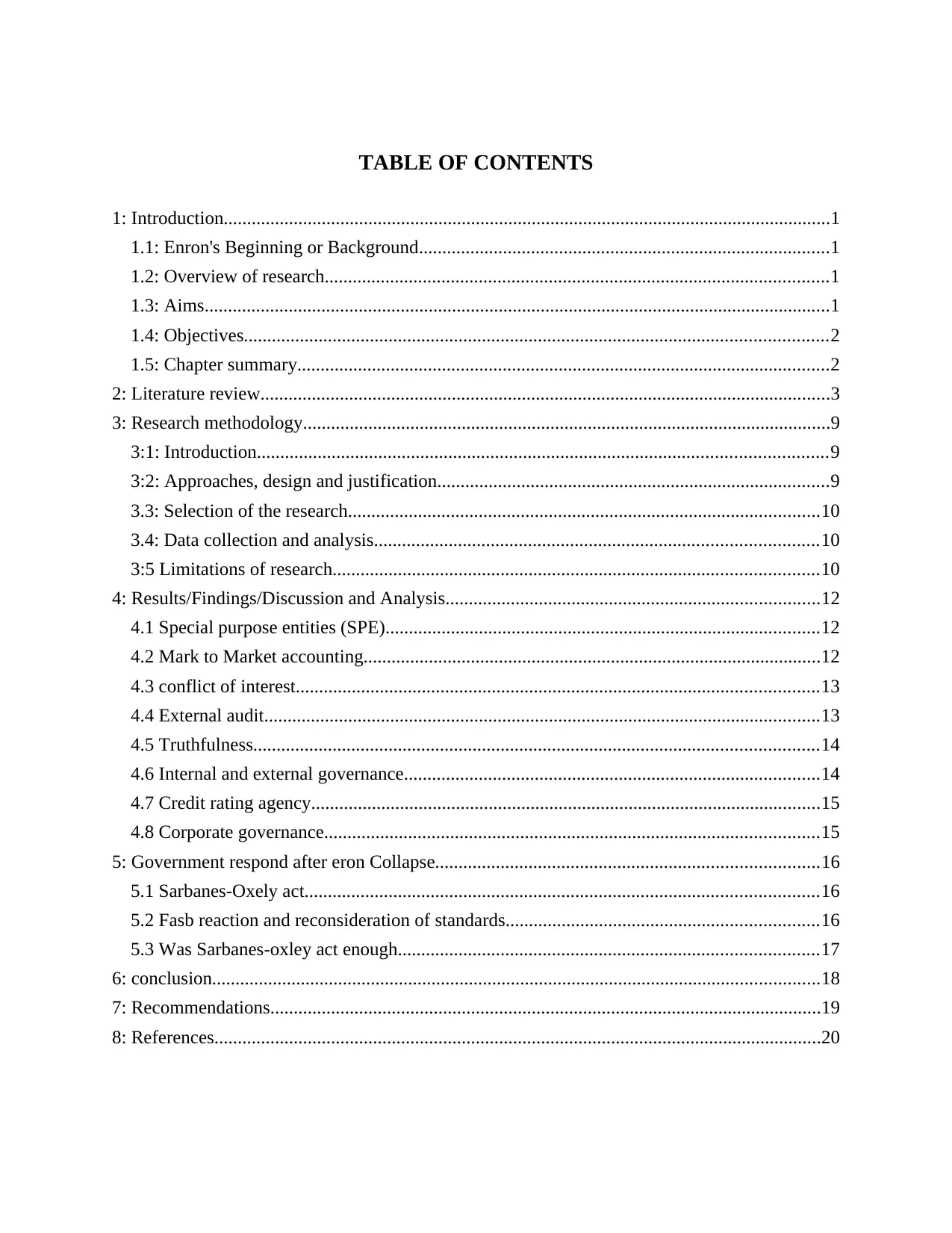
TABLE OF CONTENTS
1: Introduction..................................................................................................................................1
1.1: Enron's Beginning or Background........................................................................................1
1.2: Overview of research............................................................................................................1
1.3: Aims......................................................................................................................................1
1.4: Objectives.............................................................................................................................2
1.5: Chapter summary..................................................................................................................2
2: Literature review..........................................................................................................................3
3: Research methodology.................................................................................................................9
3:1: Introduction..........................................................................................................................9
3:2: Approaches, design and justification....................................................................................9
3.3: Selection of the research.....................................................................................................10
3.4: Data collection and analysis...............................................................................................10
3:5 Limitations of research........................................................................................................10
4: Results/Findings/Discussion and Analysis................................................................................12
4.1 Special purpose entities (SPE).............................................................................................12
4.2 Mark to Market accounting..................................................................................................12
4.3 conflict of interest................................................................................................................13
4.4 External audit.......................................................................................................................13
4.5 Truthfulness.........................................................................................................................14
4.6 Internal and external governance.........................................................................................14
4.7 Credit rating agency.............................................................................................................15
4.8 Corporate governance..........................................................................................................15
5: Government respond after eron Collapse..................................................................................16
5.1 Sarbanes-Oxely act..............................................................................................................16
5.2 Fasb reaction and reconsideration of standards...................................................................16
5.3 Was Sarbanes-oxley act enough..........................................................................................17
6: conclusion..................................................................................................................................18
7: Recommendations......................................................................................................................19
8: References..................................................................................................................................20
1: Introduction..................................................................................................................................1
1.1: Enron's Beginning or Background........................................................................................1
1.2: Overview of research............................................................................................................1
1.3: Aims......................................................................................................................................1
1.4: Objectives.............................................................................................................................2
1.5: Chapter summary..................................................................................................................2
2: Literature review..........................................................................................................................3
3: Research methodology.................................................................................................................9
3:1: Introduction..........................................................................................................................9
3:2: Approaches, design and justification....................................................................................9
3.3: Selection of the research.....................................................................................................10
3.4: Data collection and analysis...............................................................................................10
3:5 Limitations of research........................................................................................................10
4: Results/Findings/Discussion and Analysis................................................................................12
4.1 Special purpose entities (SPE).............................................................................................12
4.2 Mark to Market accounting..................................................................................................12
4.3 conflict of interest................................................................................................................13
4.4 External audit.......................................................................................................................13
4.5 Truthfulness.........................................................................................................................14
4.6 Internal and external governance.........................................................................................14
4.7 Credit rating agency.............................................................................................................15
4.8 Corporate governance..........................................................................................................15
5: Government respond after eron Collapse..................................................................................16
5.1 Sarbanes-Oxely act..............................................................................................................16
5.2 Fasb reaction and reconsideration of standards...................................................................16
5.3 Was Sarbanes-oxley act enough..........................................................................................17
6: conclusion..................................................................................................................................18
7: Recommendations......................................................................................................................19
8: References..................................................................................................................................20
Paraphrase This Document
Need a fresh take? Get an instant paraphrase of this document with our AI Paraphraser
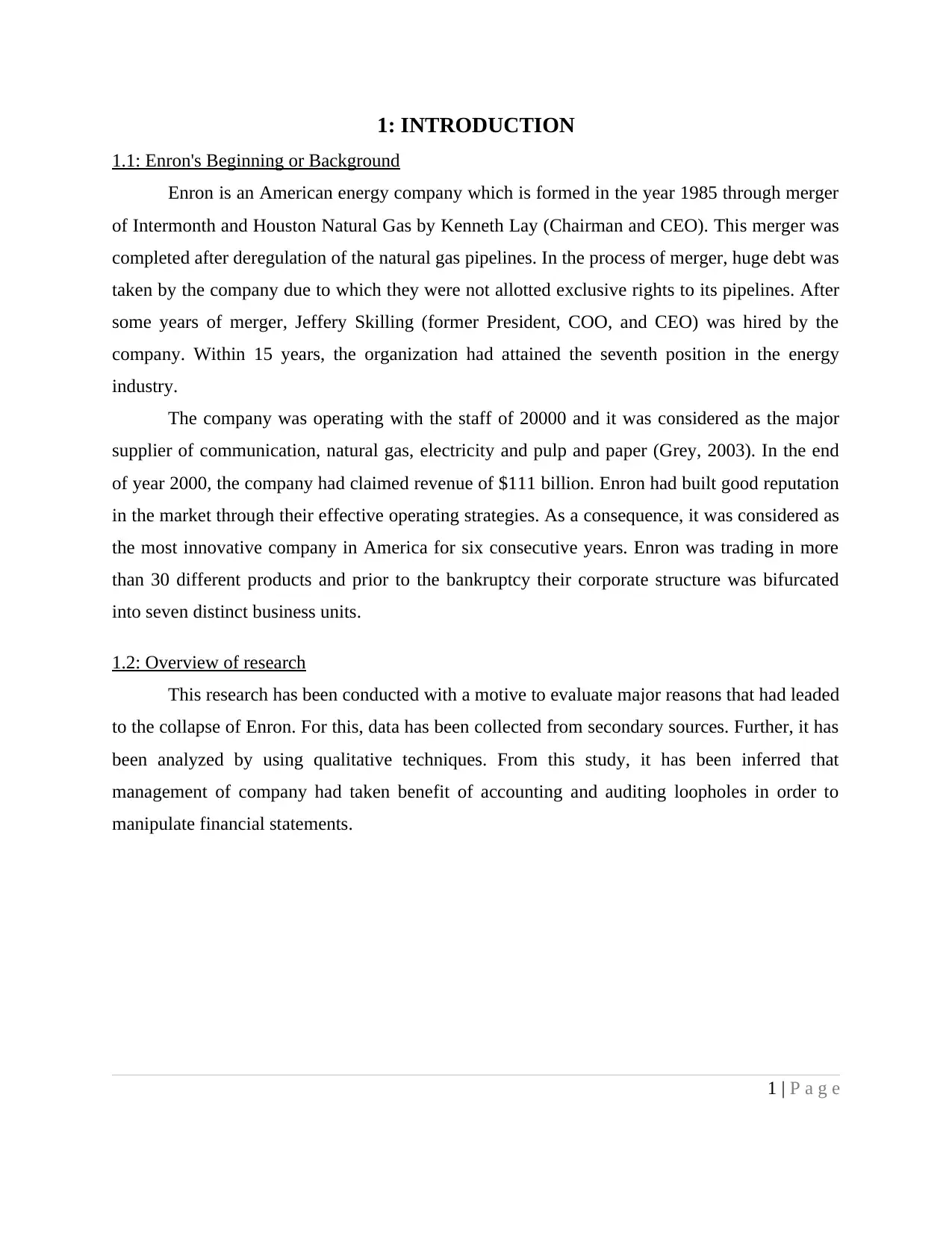
1: INTRODUCTION
1.1: Enron's Beginning or Background
Enron is an American energy company which is formed in the year 1985 through merger
of Intermonth and Houston Natural Gas by Kenneth Lay (Chairman and CEO). This merger was
completed after deregulation of the natural gas pipelines. In the process of merger, huge debt was
taken by the company due to which they were not allotted exclusive rights to its pipelines. After
some years of merger, Jeffery Skilling (former President, COO, and CEO) was hired by the
company. Within 15 years, the organization had attained the seventh position in the energy
industry.
The company was operating with the staff of 20000 and it was considered as the major
supplier of communication, natural gas, electricity and pulp and paper (Grey, 2003). In the end
of year 2000, the company had claimed revenue of $111 billion. Enron had built good reputation
in the market through their effective operating strategies. As a consequence, it was considered as
the most innovative company in America for six consecutive years. Enron was trading in more
than 30 different products and prior to the bankruptcy their corporate structure was bifurcated
into seven distinct business units.
1.2: Overview of research
This research has been conducted with a motive to evaluate major reasons that had leaded
to the collapse of Enron. For this, data has been collected from secondary sources. Further, it has
been analyzed by using qualitative techniques. From this study, it has been inferred that
management of company had taken benefit of accounting and auditing loopholes in order to
manipulate financial statements.
1 | P a g e
1.1: Enron's Beginning or Background
Enron is an American energy company which is formed in the year 1985 through merger
of Intermonth and Houston Natural Gas by Kenneth Lay (Chairman and CEO). This merger was
completed after deregulation of the natural gas pipelines. In the process of merger, huge debt was
taken by the company due to which they were not allotted exclusive rights to its pipelines. After
some years of merger, Jeffery Skilling (former President, COO, and CEO) was hired by the
company. Within 15 years, the organization had attained the seventh position in the energy
industry.
The company was operating with the staff of 20000 and it was considered as the major
supplier of communication, natural gas, electricity and pulp and paper (Grey, 2003). In the end
of year 2000, the company had claimed revenue of $111 billion. Enron had built good reputation
in the market through their effective operating strategies. As a consequence, it was considered as
the most innovative company in America for six consecutive years. Enron was trading in more
than 30 different products and prior to the bankruptcy their corporate structure was bifurcated
into seven distinct business units.
1.2: Overview of research
This research has been conducted with a motive to evaluate major reasons that had leaded
to the collapse of Enron. For this, data has been collected from secondary sources. Further, it has
been analyzed by using qualitative techniques. From this study, it has been inferred that
management of company had taken benefit of accounting and auditing loopholes in order to
manipulate financial statements.
1 | P a g e
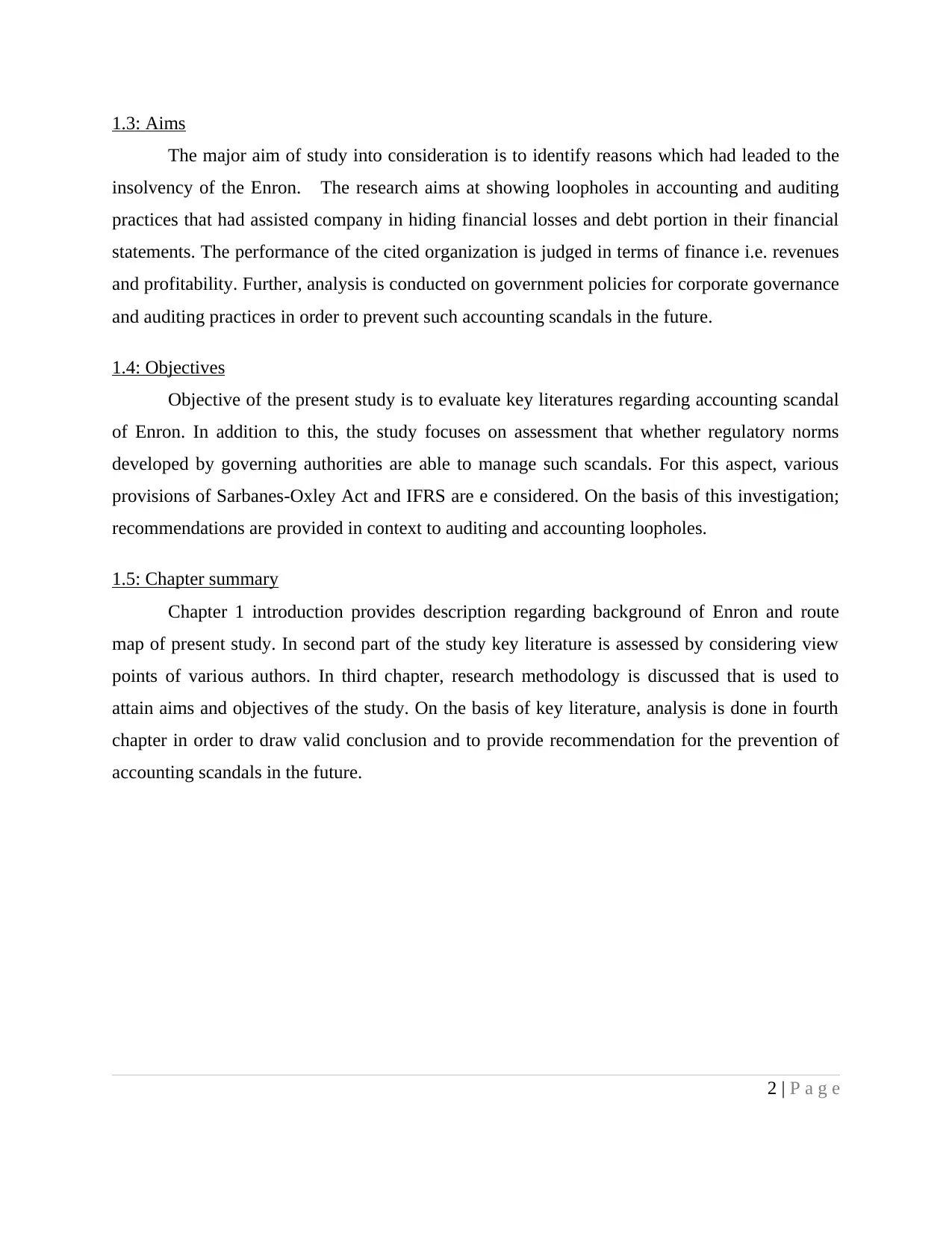
1.3: Aims
The major aim of study into consideration is to identify reasons which had leaded to the
insolvency of the Enron. The research aims at showing loopholes in accounting and auditing
practices that had assisted company in hiding financial losses and debt portion in their financial
statements. The performance of the cited organization is judged in terms of finance i.e. revenues
and profitability. Further, analysis is conducted on government policies for corporate governance
and auditing practices in order to prevent such accounting scandals in the future.
1.4: Objectives
Objective of the present study is to evaluate key literatures regarding accounting scandal
of Enron. In addition to this, the study focuses on assessment that whether regulatory norms
developed by governing authorities are able to manage such scandals. For this aspect, various
provisions of Sarbanes-Oxley Act and IFRS are e considered. On the basis of this investigation;
recommendations are provided in context to auditing and accounting loopholes.
1.5: Chapter summary
Chapter 1 introduction provides description regarding background of Enron and route
map of present study. In second part of the study key literature is assessed by considering view
points of various authors. In third chapter, research methodology is discussed that is used to
attain aims and objectives of the study. On the basis of key literature, analysis is done in fourth
chapter in order to draw valid conclusion and to provide recommendation for the prevention of
accounting scandals in the future.
2 | P a g e
The major aim of study into consideration is to identify reasons which had leaded to the
insolvency of the Enron. The research aims at showing loopholes in accounting and auditing
practices that had assisted company in hiding financial losses and debt portion in their financial
statements. The performance of the cited organization is judged in terms of finance i.e. revenues
and profitability. Further, analysis is conducted on government policies for corporate governance
and auditing practices in order to prevent such accounting scandals in the future.
1.4: Objectives
Objective of the present study is to evaluate key literatures regarding accounting scandal
of Enron. In addition to this, the study focuses on assessment that whether regulatory norms
developed by governing authorities are able to manage such scandals. For this aspect, various
provisions of Sarbanes-Oxley Act and IFRS are e considered. On the basis of this investigation;
recommendations are provided in context to auditing and accounting loopholes.
1.5: Chapter summary
Chapter 1 introduction provides description regarding background of Enron and route
map of present study. In second part of the study key literature is assessed by considering view
points of various authors. In third chapter, research methodology is discussed that is used to
attain aims and objectives of the study. On the basis of key literature, analysis is done in fourth
chapter in order to draw valid conclusion and to provide recommendation for the prevention of
accounting scandals in the future.
2 | P a g e
⊘ This is a preview!⊘
Do you want full access?
Subscribe today to unlock all pages.

Trusted by 1+ million students worldwide
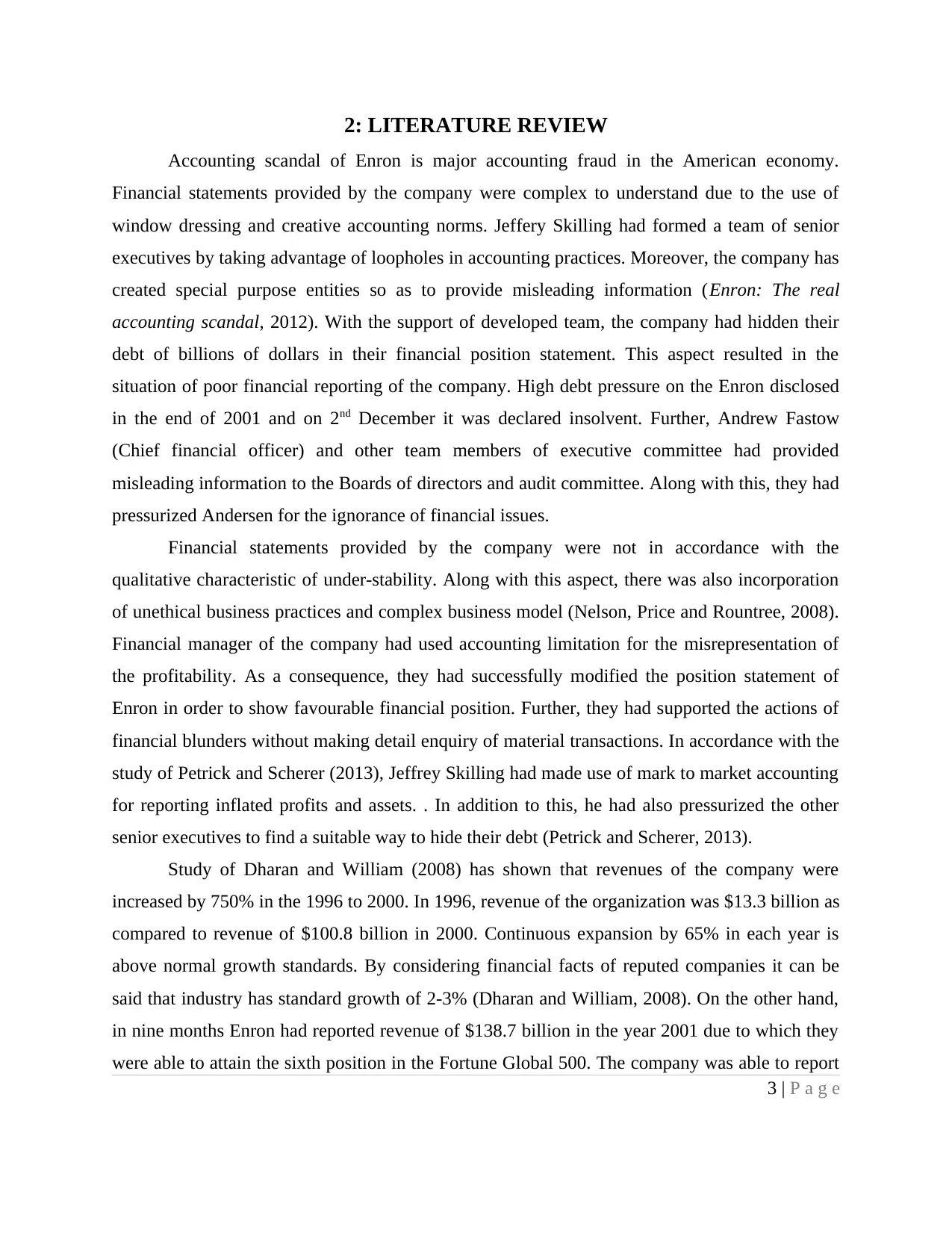
2: LITERATURE REVIEW
Accounting scandal of Enron is major accounting fraud in the American economy.
Financial statements provided by the company were complex to understand due to the use of
window dressing and creative accounting norms. Jeffery Skilling had formed a team of senior
executives by taking advantage of loopholes in accounting practices. Moreover, the company has
created special purpose entities so as to provide misleading information (Enron: The real
accounting scandal, 2012). With the support of developed team, the company had hidden their
debt of billions of dollars in their financial position statement. This aspect resulted in the
situation of poor financial reporting of the company. High debt pressure on the Enron disclosed
in the end of 2001 and on 2nd December it was declared insolvent. Further, Andrew Fastow
(Chief financial officer) and other team members of executive committee had provided
misleading information to the Boards of directors and audit committee. Along with this, they had
pressurized Andersen for the ignorance of financial issues.
Financial statements provided by the company were not in accordance with the
qualitative characteristic of under-stability. Along with this aspect, there was also incorporation
of unethical business practices and complex business model (Nelson, Price and Rountree, 2008).
Financial manager of the company had used accounting limitation for the misrepresentation of
the profitability. As a consequence, they had successfully modified the position statement of
Enron in order to show favourable financial position. Further, they had supported the actions of
financial blunders without making detail enquiry of material transactions. In accordance with the
study of Petrick and Scherer (2013), Jeffrey Skilling had made use of mark to market accounting
for reporting inflated profits and assets. . In addition to this, he had also pressurized the other
senior executives to find a suitable way to hide their debt (Petrick and Scherer, 2013).
Study of Dharan and William (2008) has shown that revenues of the company were
increased by 750% in the 1996 to 2000. In 1996, revenue of the organization was $13.3 billion as
compared to revenue of $100.8 billion in 2000. Continuous expansion by 65% in each year is
above normal growth standards. By considering financial facts of reputed companies it can be
said that industry has standard growth of 2-3% (Dharan and William, 2008). On the other hand,
in nine months Enron had reported revenue of $138.7 billion in the year 2001 due to which they
were able to attain the sixth position in the Fortune Global 500. The company was able to report
3 | P a g e
Accounting scandal of Enron is major accounting fraud in the American economy.
Financial statements provided by the company were complex to understand due to the use of
window dressing and creative accounting norms. Jeffery Skilling had formed a team of senior
executives by taking advantage of loopholes in accounting practices. Moreover, the company has
created special purpose entities so as to provide misleading information (Enron: The real
accounting scandal, 2012). With the support of developed team, the company had hidden their
debt of billions of dollars in their financial position statement. This aspect resulted in the
situation of poor financial reporting of the company. High debt pressure on the Enron disclosed
in the end of 2001 and on 2nd December it was declared insolvent. Further, Andrew Fastow
(Chief financial officer) and other team members of executive committee had provided
misleading information to the Boards of directors and audit committee. Along with this, they had
pressurized Andersen for the ignorance of financial issues.
Financial statements provided by the company were not in accordance with the
qualitative characteristic of under-stability. Along with this aspect, there was also incorporation
of unethical business practices and complex business model (Nelson, Price and Rountree, 2008).
Financial manager of the company had used accounting limitation for the misrepresentation of
the profitability. As a consequence, they had successfully modified the position statement of
Enron in order to show favourable financial position. Further, they had supported the actions of
financial blunders without making detail enquiry of material transactions. In accordance with the
study of Petrick and Scherer (2013), Jeffrey Skilling had made use of mark to market accounting
for reporting inflated profits and assets. . In addition to this, he had also pressurized the other
senior executives to find a suitable way to hide their debt (Petrick and Scherer, 2013).
Study of Dharan and William (2008) has shown that revenues of the company were
increased by 750% in the 1996 to 2000. In 1996, revenue of the organization was $13.3 billion as
compared to revenue of $100.8 billion in 2000. Continuous expansion by 65% in each year is
above normal growth standards. By considering financial facts of reputed companies it can be
said that industry has standard growth of 2-3% (Dharan and William, 2008). On the other hand,
in nine months Enron had reported revenue of $138.7 billion in the year 2001 due to which they
were able to attain the sixth position in the Fortune Global 500. The company was able to report
3 | P a g e
Paraphrase This Document
Need a fresh take? Get an instant paraphrase of this document with our AI Paraphraser
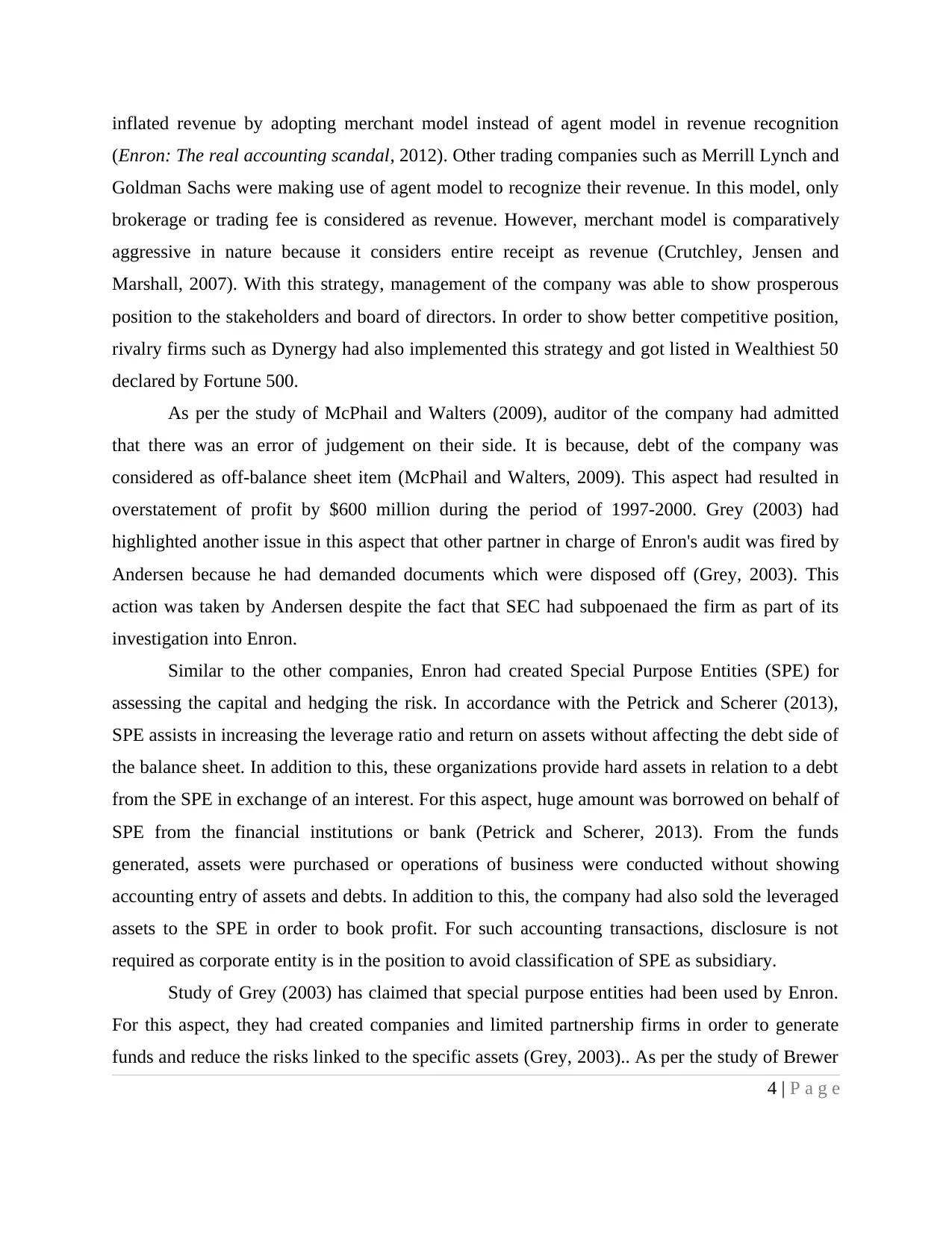
inflated revenue by adopting merchant model instead of agent model in revenue recognition
(Enron: The real accounting scandal, 2012). Other trading companies such as Merrill Lynch and
Goldman Sachs were making use of agent model to recognize their revenue. In this model, only
brokerage or trading fee is considered as revenue. However, merchant model is comparatively
aggressive in nature because it considers entire receipt as revenue (Crutchley, Jensen and
Marshall, 2007). With this strategy, management of the company was able to show prosperous
position to the stakeholders and board of directors. In order to show better competitive position,
rivalry firms such as Dynergy had also implemented this strategy and got listed in Wealthiest 50
declared by Fortune 500.
As per the study of McPhail and Walters (2009), auditor of the company had admitted
that there was an error of judgement on their side. It is because, debt of the company was
considered as off-balance sheet item (McPhail and Walters, 2009). This aspect had resulted in
overstatement of profit by $600 million during the period of 1997-2000. Grey (2003) had
highlighted another issue in this aspect that other partner in charge of Enron's audit was fired by
Andersen because he had demanded documents which were disposed off (Grey, 2003). This
action was taken by Andersen despite the fact that SEC had subpoenaed the firm as part of its
investigation into Enron.
Similar to the other companies, Enron had created Special Purpose Entities (SPE) for
assessing the capital and hedging the risk. In accordance with the Petrick and Scherer (2013),
SPE assists in increasing the leverage ratio and return on assets without affecting the debt side of
the balance sheet. In addition to this, these organizations provide hard assets in relation to a debt
from the SPE in exchange of an interest. For this aspect, huge amount was borrowed on behalf of
SPE from the financial institutions or bank (Petrick and Scherer, 2013). From the funds
generated, assets were purchased or operations of business were conducted without showing
accounting entry of assets and debts. In addition to this, the company had also sold the leveraged
assets to the SPE in order to book profit. For such accounting transactions, disclosure is not
required as corporate entity is in the position to avoid classification of SPE as subsidiary.
Study of Grey (2003) has claimed that special purpose entities had been used by Enron.
For this aspect, they had created companies and limited partnership firms in order to generate
funds and reduce the risks linked to the specific assets (Grey, 2003).. As per the study of Brewer
4 | P a g e
(Enron: The real accounting scandal, 2012). Other trading companies such as Merrill Lynch and
Goldman Sachs were making use of agent model to recognize their revenue. In this model, only
brokerage or trading fee is considered as revenue. However, merchant model is comparatively
aggressive in nature because it considers entire receipt as revenue (Crutchley, Jensen and
Marshall, 2007). With this strategy, management of the company was able to show prosperous
position to the stakeholders and board of directors. In order to show better competitive position,
rivalry firms such as Dynergy had also implemented this strategy and got listed in Wealthiest 50
declared by Fortune 500.
As per the study of McPhail and Walters (2009), auditor of the company had admitted
that there was an error of judgement on their side. It is because, debt of the company was
considered as off-balance sheet item (McPhail and Walters, 2009). This aspect had resulted in
overstatement of profit by $600 million during the period of 1997-2000. Grey (2003) had
highlighted another issue in this aspect that other partner in charge of Enron's audit was fired by
Andersen because he had demanded documents which were disposed off (Grey, 2003). This
action was taken by Andersen despite the fact that SEC had subpoenaed the firm as part of its
investigation into Enron.
Similar to the other companies, Enron had created Special Purpose Entities (SPE) for
assessing the capital and hedging the risk. In accordance with the Petrick and Scherer (2013),
SPE assists in increasing the leverage ratio and return on assets without affecting the debt side of
the balance sheet. In addition to this, these organizations provide hard assets in relation to a debt
from the SPE in exchange of an interest. For this aspect, huge amount was borrowed on behalf of
SPE from the financial institutions or bank (Petrick and Scherer, 2013). From the funds
generated, assets were purchased or operations of business were conducted without showing
accounting entry of assets and debts. In addition to this, the company had also sold the leveraged
assets to the SPE in order to book profit. For such accounting transactions, disclosure is not
required as corporate entity is in the position to avoid classification of SPE as subsidiary.
Study of Grey (2003) has claimed that special purpose entities had been used by Enron.
For this aspect, they had created companies and limited partnership firms in order to generate
funds and reduce the risks linked to the specific assets (Grey, 2003).. As per the study of Brewer
4 | P a g e
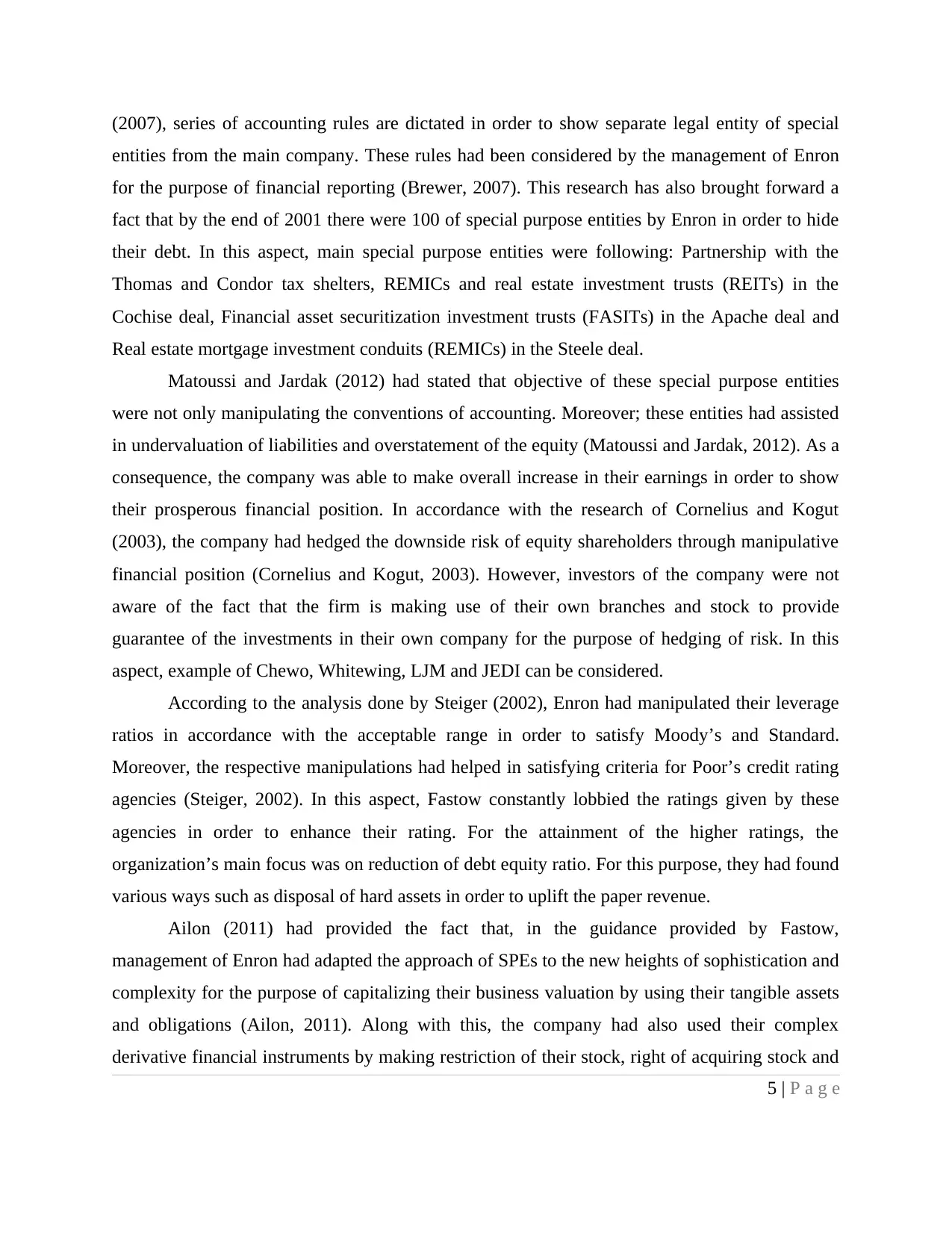
(2007), series of accounting rules are dictated in order to show separate legal entity of special
entities from the main company. These rules had been considered by the management of Enron
for the purpose of financial reporting (Brewer, 2007). This research has also brought forward a
fact that by the end of 2001 there were 100 of special purpose entities by Enron in order to hide
their debt. In this aspect, main special purpose entities were following: Partnership with the
Thomas and Condor tax shelters, REMICs and real estate investment trusts (REITs) in the
Cochise deal, Financial asset securitization investment trusts (FASITs) in the Apache deal and
Real estate mortgage investment conduits (REMICs) in the Steele deal.
Matoussi and Jardak (2012) had stated that objective of these special purpose entities
were not only manipulating the conventions of accounting. Moreover; these entities had assisted
in undervaluation of liabilities and overstatement of the equity (Matoussi and Jardak, 2012). As a
consequence, the company was able to make overall increase in their earnings in order to show
their prosperous financial position. In accordance with the research of Cornelius and Kogut
(2003), the company had hedged the downside risk of equity shareholders through manipulative
financial position (Cornelius and Kogut, 2003). However, investors of the company were not
aware of the fact that the firm is making use of their own branches and stock to provide
guarantee of the investments in their own company for the purpose of hedging of risk. In this
aspect, example of Chewo, Whitewing, LJM and JEDI can be considered.
According to the analysis done by Steiger (2002), Enron had manipulated their leverage
ratios in accordance with the acceptable range in order to satisfy Moody’s and Standard.
Moreover, the respective manipulations had helped in satisfying criteria for Poor’s credit rating
agencies (Steiger, 2002). In this aspect, Fastow constantly lobbied the ratings given by these
agencies in order to enhance their rating. For the attainment of the higher ratings, the
organization’s main focus was on reduction of debt equity ratio. For this purpose, they had found
various ways such as disposal of hard assets in order to uplift the paper revenue.
Ailon (2011) had provided the fact that, in the guidance provided by Fastow,
management of Enron had adapted the approach of SPEs to the new heights of sophistication and
complexity for the purpose of capitalizing their business valuation by using their tangible assets
and obligations (Ailon, 2011). Along with this, the company had also used their complex
derivative financial instruments by making restriction of their stock, right of acquiring stock and
5 | P a g e
entities from the main company. These rules had been considered by the management of Enron
for the purpose of financial reporting (Brewer, 2007). This research has also brought forward a
fact that by the end of 2001 there were 100 of special purpose entities by Enron in order to hide
their debt. In this aspect, main special purpose entities were following: Partnership with the
Thomas and Condor tax shelters, REMICs and real estate investment trusts (REITs) in the
Cochise deal, Financial asset securitization investment trusts (FASITs) in the Apache deal and
Real estate mortgage investment conduits (REMICs) in the Steele deal.
Matoussi and Jardak (2012) had stated that objective of these special purpose entities
were not only manipulating the conventions of accounting. Moreover; these entities had assisted
in undervaluation of liabilities and overstatement of the equity (Matoussi and Jardak, 2012). As a
consequence, the company was able to make overall increase in their earnings in order to show
their prosperous financial position. In accordance with the research of Cornelius and Kogut
(2003), the company had hedged the downside risk of equity shareholders through manipulative
financial position (Cornelius and Kogut, 2003). However, investors of the company were not
aware of the fact that the firm is making use of their own branches and stock to provide
guarantee of the investments in their own company for the purpose of hedging of risk. In this
aspect, example of Chewo, Whitewing, LJM and JEDI can be considered.
According to the analysis done by Steiger (2002), Enron had manipulated their leverage
ratios in accordance with the acceptable range in order to satisfy Moody’s and Standard.
Moreover, the respective manipulations had helped in satisfying criteria for Poor’s credit rating
agencies (Steiger, 2002). In this aspect, Fastow constantly lobbied the ratings given by these
agencies in order to enhance their rating. For the attainment of the higher ratings, the
organization’s main focus was on reduction of debt equity ratio. For this purpose, they had found
various ways such as disposal of hard assets in order to uplift the paper revenue.
Ailon (2011) had provided the fact that, in the guidance provided by Fastow,
management of Enron had adapted the approach of SPEs to the new heights of sophistication and
complexity for the purpose of capitalizing their business valuation by using their tangible assets
and obligations (Ailon, 2011). Along with this, the company had also used their complex
derivative financial instruments by making restriction of their stock, right of acquiring stock and
5 | P a g e
⊘ This is a preview!⊘
Do you want full access?
Subscribe today to unlock all pages.

Trusted by 1+ million students worldwide
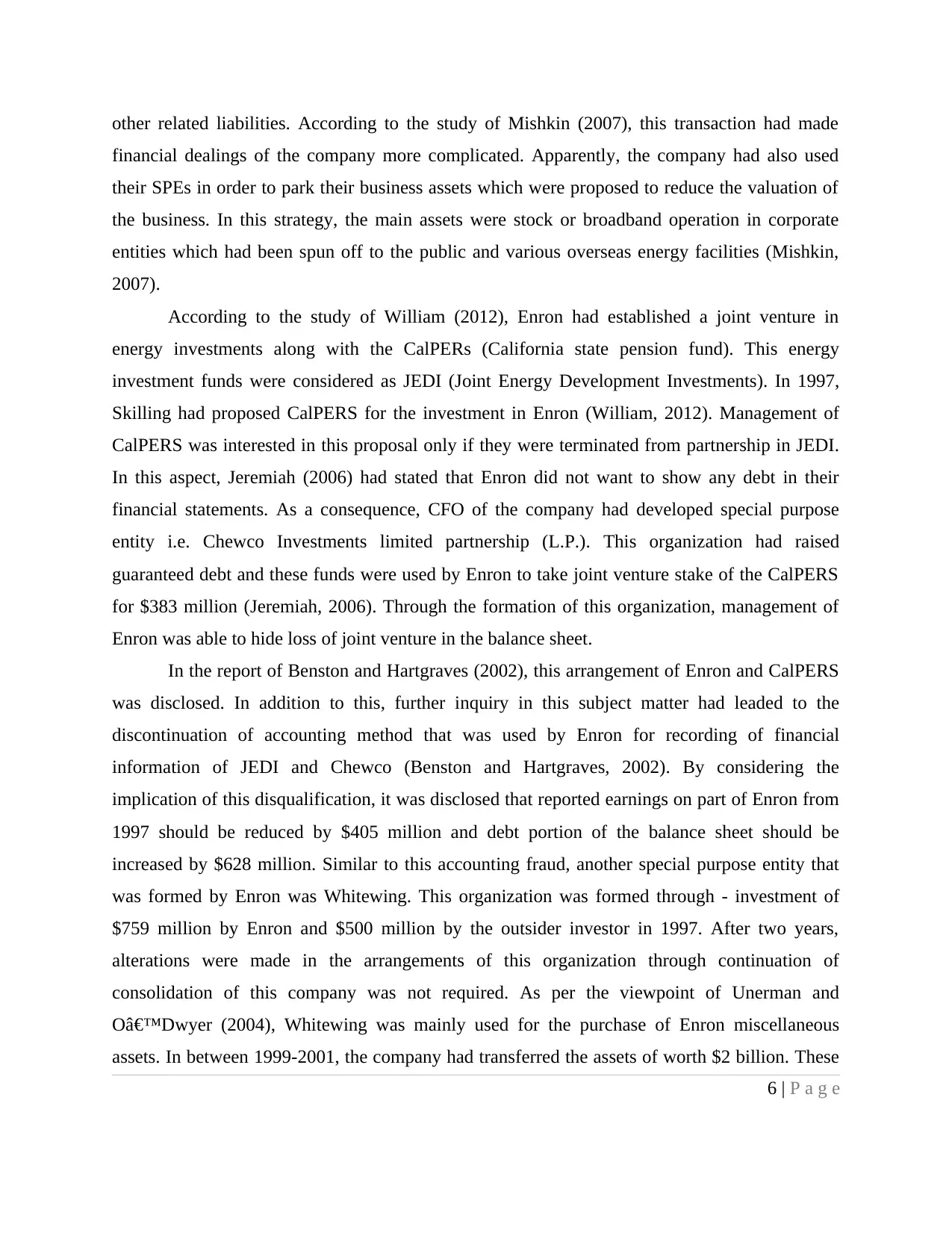
other related liabilities. According to the study of Mishkin (2007), this transaction had made
financial dealings of the company more complicated. Apparently, the company had also used
their SPEs in order to park their business assets which were proposed to reduce the valuation of
the business. In this strategy, the main assets were stock or broadband operation in corporate
entities which had been spun off to the public and various overseas energy facilities (Mishkin,
2007).
According to the study of William (2012), Enron had established a joint venture in
energy investments along with the CalPERs (California state pension fund). This energy
investment funds were considered as JEDI (Joint Energy Development Investments). In 1997,
Skilling had proposed CalPERS for the investment in Enron (William, 2012). Management of
CalPERS was interested in this proposal only if they were terminated from partnership in JEDI.
In this aspect, Jeremiah (2006) had stated that Enron did not want to show any debt in their
financial statements. As a consequence, CFO of the company had developed special purpose
entity i.e. Chewco Investments limited partnership (L.P.). This organization had raised
guaranteed debt and these funds were used by Enron to take joint venture stake of the CalPERS
for $383 million (Jeremiah, 2006). Through the formation of this organization, management of
Enron was able to hide loss of joint venture in the balance sheet.
In the report of Benston and Hartgraves (2002), this arrangement of Enron and CalPERS
was disclosed. In addition to this, further inquiry in this subject matter had leaded to the
discontinuation of accounting method that was used by Enron for recording of financial
information of JEDI and Chewco (Benston and Hartgraves, 2002). By considering the
implication of this disqualification, it was disclosed that reported earnings on part of Enron from
1997 should be reduced by $405 million and debt portion of the balance sheet should be
increased by $628 million. Similar to this accounting fraud, another special purpose entity that
was formed by Enron was Whitewing. This organization was formed through - investment of
$759 million by Enron and $500 million by the outsider investor in 1997. After two years,
alterations were made in the arrangements of this organization through continuation of
consolidation of this company was not required. As per the viewpoint of Unerman and
O’Dwyer (2004), Whitewing was mainly used for the purchase of Enron miscellaneous
assets. In between 1999-2001, the company had transferred the assets of worth $2 billion. These
6 | P a g e
financial dealings of the company more complicated. Apparently, the company had also used
their SPEs in order to park their business assets which were proposed to reduce the valuation of
the business. In this strategy, the main assets were stock or broadband operation in corporate
entities which had been spun off to the public and various overseas energy facilities (Mishkin,
2007).
According to the study of William (2012), Enron had established a joint venture in
energy investments along with the CalPERs (California state pension fund). This energy
investment funds were considered as JEDI (Joint Energy Development Investments). In 1997,
Skilling had proposed CalPERS for the investment in Enron (William, 2012). Management of
CalPERS was interested in this proposal only if they were terminated from partnership in JEDI.
In this aspect, Jeremiah (2006) had stated that Enron did not want to show any debt in their
financial statements. As a consequence, CFO of the company had developed special purpose
entity i.e. Chewco Investments limited partnership (L.P.). This organization had raised
guaranteed debt and these funds were used by Enron to take joint venture stake of the CalPERS
for $383 million (Jeremiah, 2006). Through the formation of this organization, management of
Enron was able to hide loss of joint venture in the balance sheet.
In the report of Benston and Hartgraves (2002), this arrangement of Enron and CalPERS
was disclosed. In addition to this, further inquiry in this subject matter had leaded to the
discontinuation of accounting method that was used by Enron for recording of financial
information of JEDI and Chewco (Benston and Hartgraves, 2002). By considering the
implication of this disqualification, it was disclosed that reported earnings on part of Enron from
1997 should be reduced by $405 million and debt portion of the balance sheet should be
increased by $628 million. Similar to this accounting fraud, another special purpose entity that
was formed by Enron was Whitewing. This organization was formed through - investment of
$759 million by Enron and $500 million by the outsider investor in 1997. After two years,
alterations were made in the arrangements of this organization through continuation of
consolidation of this company was not required. As per the viewpoint of Unerman and
O’Dwyer (2004), Whitewing was mainly used for the purchase of Enron miscellaneous
assets. In between 1999-2001, the company had transferred the assets of worth $2 billion. These
6 | P a g e
Paraphrase This Document
Need a fresh take? Get an instant paraphrase of this document with our AI Paraphraser
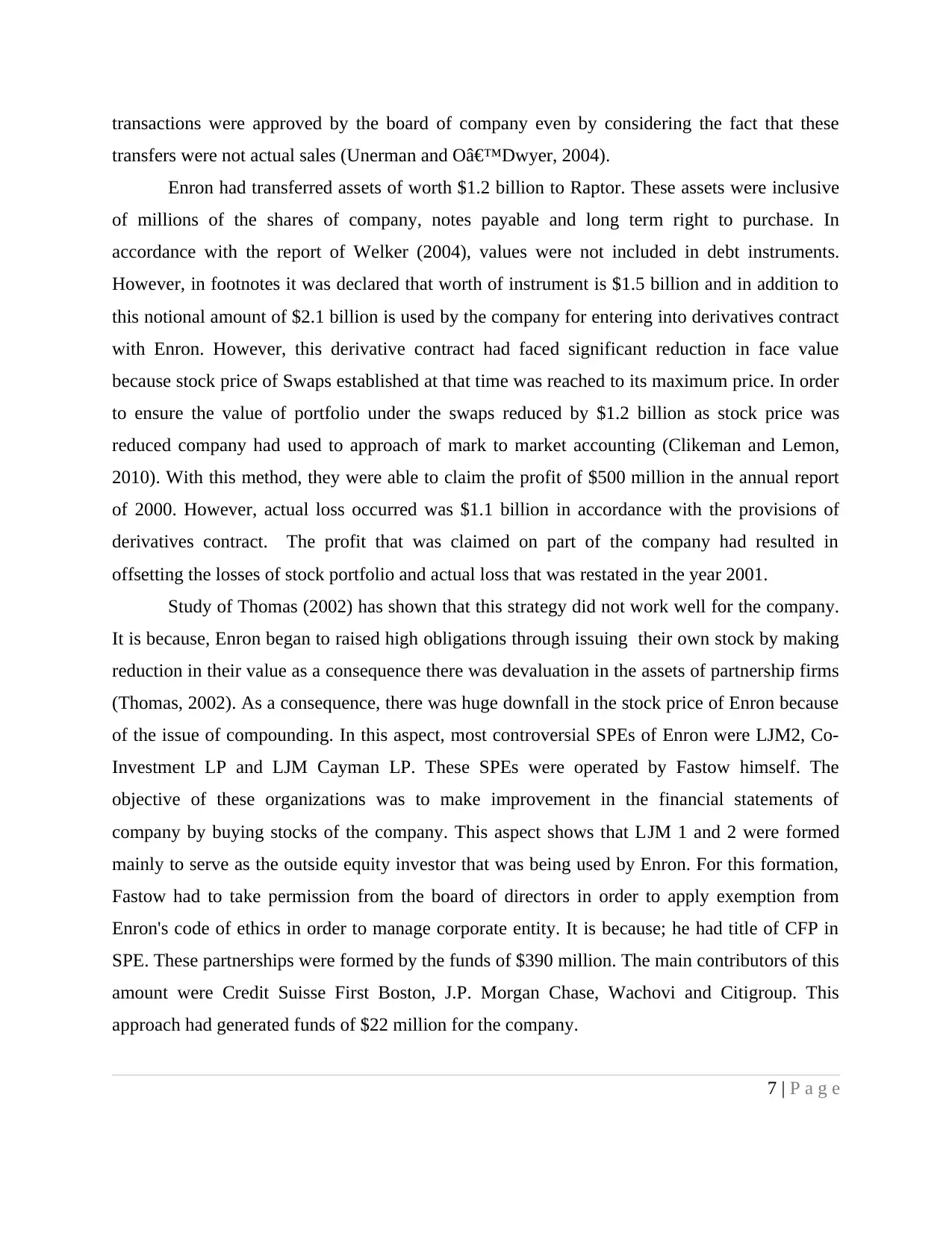
transactions were approved by the board of company even by considering the fact that these
transfers were not actual sales (Unerman and O’Dwyer, 2004).
Enron had transferred assets of worth $1.2 billion to Raptor. These assets were inclusive
of millions of the shares of company, notes payable and long term right to purchase. In
accordance with the report of Welker (2004), values were not included in debt instruments.
However, in footnotes it was declared that worth of instrument is $1.5 billion and in addition to
this notional amount of $2.1 billion is used by the company for entering into derivatives contract
with Enron. However, this derivative contract had faced significant reduction in face value
because stock price of Swaps established at that time was reached to its maximum price. In order
to ensure the value of portfolio under the swaps reduced by $1.2 billion as stock price was
reduced company had used to approach of mark to market accounting (Clikeman and Lemon,
2010). With this method, they were able to claim the profit of $500 million in the annual report
of 2000. However, actual loss occurred was $1.1 billion in accordance with the provisions of
derivatives contract. The profit that was claimed on part of the company had resulted in
offsetting the losses of stock portfolio and actual loss that was restated in the year 2001.
Study of Thomas (2002) has shown that this strategy did not work well for the company.
It is because, Enron began to raised high obligations through issuing their own stock by making
reduction in their value as a consequence there was devaluation in the assets of partnership firms
(Thomas, 2002). As a consequence, there was huge downfall in the stock price of Enron because
of the issue of compounding. In this aspect, most controversial SPEs of Enron were LJM2, Co-
Investment LP and LJM Cayman LP. These SPEs were operated by Fastow himself. The
objective of these organizations was to make improvement in the financial statements of
company by buying stocks of the company. This aspect shows that LJM 1 and 2 were formed
mainly to serve as the outside equity investor that was being used by Enron. For this formation,
Fastow had to take permission from the board of directors in order to apply exemption from
Enron's code of ethics in order to manage corporate entity. It is because; he had title of CFP in
SPE. These partnerships were formed by the funds of $390 million. The main contributors of this
amount were Credit Suisse First Boston, J.P. Morgan Chase, Wachovi and Citigroup. This
approach had generated funds of $22 million for the company.
7 | P a g e
transfers were not actual sales (Unerman and O’Dwyer, 2004).
Enron had transferred assets of worth $1.2 billion to Raptor. These assets were inclusive
of millions of the shares of company, notes payable and long term right to purchase. In
accordance with the report of Welker (2004), values were not included in debt instruments.
However, in footnotes it was declared that worth of instrument is $1.5 billion and in addition to
this notional amount of $2.1 billion is used by the company for entering into derivatives contract
with Enron. However, this derivative contract had faced significant reduction in face value
because stock price of Swaps established at that time was reached to its maximum price. In order
to ensure the value of portfolio under the swaps reduced by $1.2 billion as stock price was
reduced company had used to approach of mark to market accounting (Clikeman and Lemon,
2010). With this method, they were able to claim the profit of $500 million in the annual report
of 2000. However, actual loss occurred was $1.1 billion in accordance with the provisions of
derivatives contract. The profit that was claimed on part of the company had resulted in
offsetting the losses of stock portfolio and actual loss that was restated in the year 2001.
Study of Thomas (2002) has shown that this strategy did not work well for the company.
It is because, Enron began to raised high obligations through issuing their own stock by making
reduction in their value as a consequence there was devaluation in the assets of partnership firms
(Thomas, 2002). As a consequence, there was huge downfall in the stock price of Enron because
of the issue of compounding. In this aspect, most controversial SPEs of Enron were LJM2, Co-
Investment LP and LJM Cayman LP. These SPEs were operated by Fastow himself. The
objective of these organizations was to make improvement in the financial statements of
company by buying stocks of the company. This aspect shows that LJM 1 and 2 were formed
mainly to serve as the outside equity investor that was being used by Enron. For this formation,
Fastow had to take permission from the board of directors in order to apply exemption from
Enron's code of ethics in order to manage corporate entity. It is because; he had title of CFP in
SPE. These partnerships were formed by the funds of $390 million. The main contributors of this
amount were Credit Suisse First Boston, J.P. Morgan Chase, Wachovi and Citigroup. This
approach had generated funds of $22 million for the company.
7 | P a g e
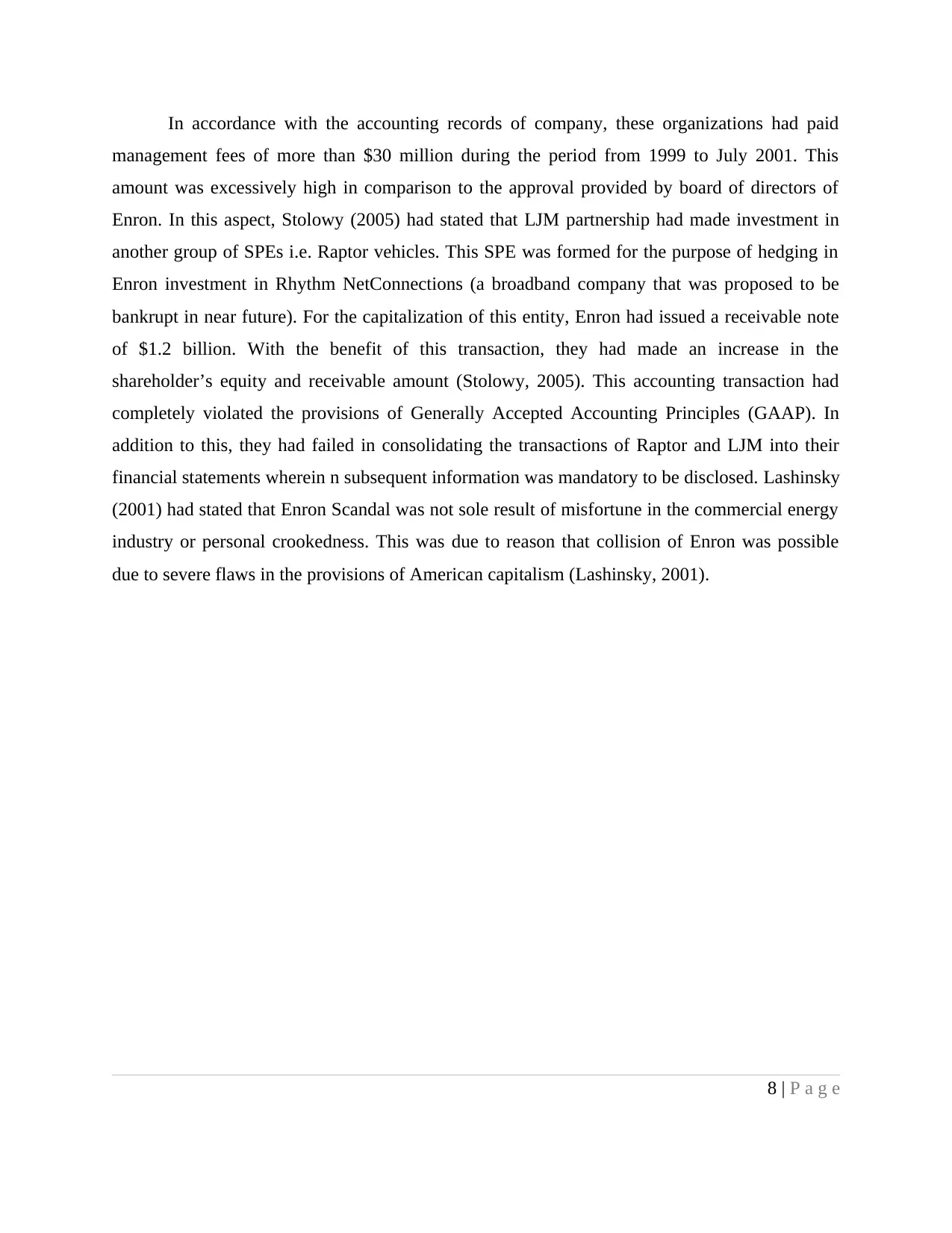
In accordance with the accounting records of company, these organizations had paid
management fees of more than $30 million during the period from 1999 to July 2001. This
amount was excessively high in comparison to the approval provided by board of directors of
Enron. In this aspect, Stolowy (2005) had stated that LJM partnership had made investment in
another group of SPEs i.e. Raptor vehicles. This SPE was formed for the purpose of hedging in
Enron investment in Rhythm NetConnections (a broadband company that was proposed to be
bankrupt in near future). For the capitalization of this entity, Enron had issued a receivable note
of $1.2 billion. With the benefit of this transaction, they had made an increase in the
shareholder’s equity and receivable amount (Stolowy, 2005). This accounting transaction had
completely violated the provisions of Generally Accepted Accounting Principles (GAAP). In
addition to this, they had failed in consolidating the transactions of Raptor and LJM into their
financial statements wherein n subsequent information was mandatory to be disclosed. Lashinsky
(2001) had stated that Enron Scandal was not sole result of misfortune in the commercial energy
industry or personal crookedness. This was due to reason that collision of Enron was possible
due to severe flaws in the provisions of American capitalism (Lashinsky, 2001).
8 | P a g e
management fees of more than $30 million during the period from 1999 to July 2001. This
amount was excessively high in comparison to the approval provided by board of directors of
Enron. In this aspect, Stolowy (2005) had stated that LJM partnership had made investment in
another group of SPEs i.e. Raptor vehicles. This SPE was formed for the purpose of hedging in
Enron investment in Rhythm NetConnections (a broadband company that was proposed to be
bankrupt in near future). For the capitalization of this entity, Enron had issued a receivable note
of $1.2 billion. With the benefit of this transaction, they had made an increase in the
shareholder’s equity and receivable amount (Stolowy, 2005). This accounting transaction had
completely violated the provisions of Generally Accepted Accounting Principles (GAAP). In
addition to this, they had failed in consolidating the transactions of Raptor and LJM into their
financial statements wherein n subsequent information was mandatory to be disclosed. Lashinsky
(2001) had stated that Enron Scandal was not sole result of misfortune in the commercial energy
industry or personal crookedness. This was due to reason that collision of Enron was possible
due to severe flaws in the provisions of American capitalism (Lashinsky, 2001).
8 | P a g e
⊘ This is a preview!⊘
Do you want full access?
Subscribe today to unlock all pages.

Trusted by 1+ million students worldwide
1 out of 27
Related Documents
Your All-in-One AI-Powered Toolkit for Academic Success.
+13062052269
info@desklib.com
Available 24*7 on WhatsApp / Email
![[object Object]](/_next/static/media/star-bottom.7253800d.svg)
Unlock your academic potential
Copyright © 2020–2025 A2Z Services. All Rights Reserved. Developed and managed by ZUCOL.





